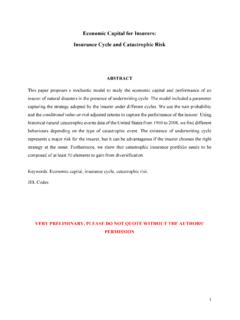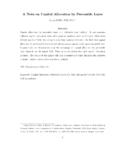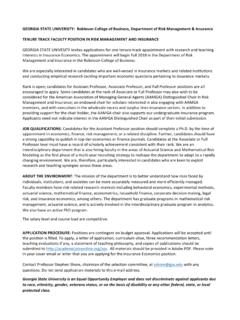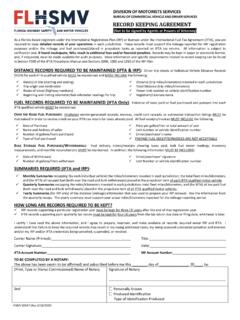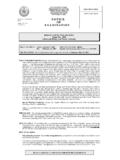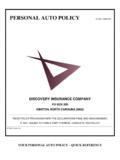Transcription of The Demand for Automobile Insurance: Evidence …
1 The Demand for Automobile insurance : Evidence from underserved Areas in California Melvin T. Stith, Jr. and Robert E. Hoyt University of Georgia Brooks Hall 206. Terry College of Business University of Georgia Athens, GA 30602-6255. Tel. (706) 542-4290. Fax (706) 542-4295. Email: July 19, 2012. The Demand for Automobile insurance : Evidence from underserved Areas in California Abstract Automobile insurance availability is a serious issue for motorists, regulators and the insurance industry. The costs imposed on the system by uninsured motorists are not trivial. In order to minimize these costs it is necessary to understand the factors that lead motorists to drive without insurance . This paper uses data reported to the California Department of insurance , as well as demographic data collected at the ZIP code level, to analyze the Demand for auto insurance in areas that the California Department of insurance has designated as underserved .
2 The results show that areas as measured by ZIP codes that are saddled with high poverty and areas that are predominately urban are more likely to have lower Demand for Automobile insurance . However, the fact that a certain area is predominately minority does not alone make it more likely to exhibit lower Demand for Automobile insurance . Introduction It has long been recognized that having access to affordable insurance is critical to everyday life in American society. insurance is even more important in the Automobile context because many states have mandated that motorists purchase insurance . As important as insurance is to the average American citizen, it is even more essential for urban communities and has been for some time. In 1968, a federal advisory committee observed: insurance is essential to revitalize our cities.
3 It is a cornerstone of credit. Without insurance , banks and other financial institutions will not and cannot make loans. New housing cannot be constructed, and existing housing cannot be repaired. New businesses cannot expand, or even survive. Without insurance , buildings are left to deteriorate; services, goods and jobs diminish. Efforts to rebuild our nation's inner cities cannot move forward. Communities without insurance are communities without hope. (President's National Advisory Panel, 1968). As the preceding paragraphs illustrate, a better understanding of both the Demand and availability of insurance could have profound public policy implications; particularly if it led to a better understanding of the availability or lack thereof of insurance in urban areas where it is so badly needed. The need to understand the availability of insurance is especially urgent in the context of Automobile insurance .
4 Because state law mandates Automobile insurance in most states as a necessary prerequisite to driving, not being able to secure insurance means that many otherwise qualified people do not have access to an 1. Automobile . This reality can have severe implications for many minorities living in urban areas because they are often denied opportunities for employment in suburban areas simply because they lack the transportation to get to the job site (Raphael and Stoll, 2001). However, because car ownership rates for low skilled workers are sensitive to small changes in operating costs, even a small change in cost or availability of auto insurance can have a significant impact in opening opportunities for minorities everywhere, but especially in urban areas (Raphael and Rice, 2000). Statistics show that this access problem is particularly acute in California because so many people rely on automobiles to get to work.
5 According to the Census 2000 conducted by the Census Bureau, 10,432,462 workers over 16 years of age, which is of all workers over 16, drive to work alone in a car, truck or van. According to the 2000 census another 2,113,313 workers over 16, or of all workers over 16, carpool to work in a car, truck or van. That means 12,545,775 workers over 16 years of age or of all workers over 16 rely on a car, truck or van to get to work. Only 1,979,547 workers over 16 or of all workers over 16 walk to work, use public transportation or work at home. These statistics illustrate how important it is for people to have access to Automobile insurance to allow them to get to work. This problem of securing access to Automobile insurance for those who perhaps need it the most was one of the major reasons that led California to enact the provisions creating the underserved ' designation.
6 As the California Department of insurance (CDI) says on its website, The purpose of the regulations is to address the issue of availability and affordability of insurance in " underserved " communities and to promote anti- discrimination so that all have equal access to insurance coverage in California. California has placed significant focus on addressing this problem of inadequate access to Automobile insurance . It is doing this not only through its creation of the underserved designation, but also through increasing the level of transparency in the insurance industry by requiring insurers to publicly disclose data from home, personal auto, commercial multiple peril and commercial fire policies in California, in all ZIP codes identified as " underserved ". The California Commissioner of insurance collects and reports earned exposures for the affected lines, as well as the number of agents and service offices in the underserved areas as a percentage of statewide totals for each insurance company.
7 2. California is an ideal state in which to conduct this study for several reasons. Not only does it provide a workable framework for studying these access issues through its creation of the underserved designation, it also provides an unprecedented level of transparency discussed above that allows us to study the impact of demographics on access to Automobile insurance . Demographically, California also provides an excellent laboratory in which to study why certain areas have issues with Automobile insurance access. Besides being the most heavily populated state in the United States with nearly 34 million residents, California provides a great deal of diversity because it contains large numbers of different ethnic groups and it has many different levels of income and education stratification. According to the most recent census taken in 2000, of California residents were born in foreign countries and of California residents belong to families that speak a language other than English in the home.
8 For comparison purposes, of United States residents were born in foreign countries and of all Americans belong to families that speak a language other than English in the home. With respect to social diversity, of California are white, Black or African American, Asian. Additionally, identify themselves as Hispanic or Latino. This study will present and then estimate a model of the Demand for insurance in areas deemed underserved by the California Department of insurance , areas that are almost underserved and finally the state of California as a whole. These three areas are used to determine whether there are factors that are affecting Demand differently in these three areas. Demographic data obtained from the 2000 United States Census is then used to regress the insurance Demand variable on various factors such as poverty, income, minority status and whether the area is urban or rural.
9 The goal of this study is to attempt to pinpoint factors that exist in these almost underserved areas that may be used to help lower the uninsured motorist rate in those areas that meet the full definition of underserved as defined by the California Department of insurance . These factors will help us to better explain why people exhibit a Demand for auto insurance . We will investigate potential barriers that need to be overcome so that access to insurance is improved for all potential motorists whether or not they happen to live in underserved or almost underserved areas. Previous literature has focused on discrimination in insurance in the form of redlining that raises prices and restricts the availability of coverage (Squires, DeWolfe, and DeWolfe, 1979; Squires, Velez, and 3. Taeuber, 1991). Harrington and Niehaus investigated whether racial discrimination affects market prices of auto insurance in Missouri (Harrington and Niehaus, 1998).
10 This paper employs a framework established by a state government to examine factors that influence Automobile insurance Demand . This analysis will allow us to provide direct advice to the state in order to improve the underserved framework so that California can better effectuate its goal of increased access to Automobile insurance for all Californians. Because of the degree of specificity of the data that insurers are required to report in California, we are able to directly observe the uninsured motorist rate in underserved communities and compare it to the uninsured motorist rate in California as a whole. Because Automobile insurance is mandatory under California law in order to drive, employing the uninsured motorist rate allows us to use a very direct measure of auto insurance Demand in order to investigate insurance access rather than concentrating on insurance pricing or firm profits.



